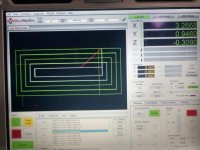Hey there guys, once again I find myself in a position where I need to figure everything out with little to no experience around me. For those of you that remember a few years ago I was let loose on a Romi M27 lathe with zero experience. I have spent most of my time since that first shop working as a lathe operator at another shop. And here I am a few years later being let loose on a portable CNC mill. I momentarily had a "lead" machinist with 25+ years experience working with me but he left 2 weeks in for more pay at his previous employer. And for 2 months now I don't think my employer is going to hire a replacement.
For starters this mill was purchased new from Mirage, it came custom retrofitted with MachMotion Servos and Control. (I was not here for that decision making process) The machine has a max feed/rapid rate of about 40ipm and max spindle speed of 1500RPM. Also worth mentioning is that this machine has the rigidity of a wet kitchen sponge. The body of the machine is made of aluminum with some linear ways bolted to the top. The lead screw is 10MM per turn and is attached to the servo through a 40:1 gearbox. Sadly the backlash on this machine is 0.018 on the Y and about .032 on the X.
On to the application, this machine was purchased with the intention to machine pockets into large forging dies made of FX2 die steel. The pockets are about 6x12.5x2.17. We intend to layout the location of the pockets onto the dies then bolt the machine to the die itself and machine the pockets that way since moving these 45,000lb dies is quite a challenge.
As for tooling, originally the powers that be decided that we should purchase high feed high speed tooling with the hopes of watching this aluminum bodied machine run around at 100ipm. Since most/all of my experience is running a lathe I'm not quite sure what tooling is best for a machine with such poor rigidity. We have 1in carbide endmills, we have 50MM (1.9865in) shell mills we have ball endmills for the bottom radii. The shell mills and inserts are from Tungaloy their TungTri line.
For programming I've been using a CAM package that came with the machine which they've called "Alexsys" but is labeled eCAM. Thats worked fine so far but it has its limitations.
Currently my problem is that even if I get it cutting beautifully with the 50MM shell mill, if it hits a hard spot or anything the whole Y axis will shake causing the inserts to smack the part and break.
Any help or advice would be appreciated. (Calling my employer an idiot is not constructive I've tried)
For starters this mill was purchased new from Mirage, it came custom retrofitted with MachMotion Servos and Control. (I was not here for that decision making process) The machine has a max feed/rapid rate of about 40ipm and max spindle speed of 1500RPM. Also worth mentioning is that this machine has the rigidity of a wet kitchen sponge. The body of the machine is made of aluminum with some linear ways bolted to the top. The lead screw is 10MM per turn and is attached to the servo through a 40:1 gearbox. Sadly the backlash on this machine is 0.018 on the Y and about .032 on the X.
On to the application, this machine was purchased with the intention to machine pockets into large forging dies made of FX2 die steel. The pockets are about 6x12.5x2.17. We intend to layout the location of the pockets onto the dies then bolt the machine to the die itself and machine the pockets that way since moving these 45,000lb dies is quite a challenge.
As for tooling, originally the powers that be decided that we should purchase high feed high speed tooling with the hopes of watching this aluminum bodied machine run around at 100ipm. Since most/all of my experience is running a lathe I'm not quite sure what tooling is best for a machine with such poor rigidity. We have 1in carbide endmills, we have 50MM (1.9865in) shell mills we have ball endmills for the bottom radii. The shell mills and inserts are from Tungaloy their TungTri line.
For programming I've been using a CAM package that came with the machine which they've called "Alexsys" but is labeled eCAM. Thats worked fine so far but it has its limitations.
Currently my problem is that even if I get it cutting beautifully with the 50MM shell mill, if it hits a hard spot or anything the whole Y axis will shake causing the inserts to smack the part and break.
Any help or advice would be appreciated. (Calling my employer an idiot is not constructive I've tried)





